Although the idea that radio waves -- called "Hertzian waves" in this review -- might someday be used for eliminating fog occurred to many experimenters, no practical system was ever actually developed.
Technical World Magazine, July, 1909, pages 520-523:
FIGHTING FOG WITH HERTZIAN WAVES
By EDFRID A. BINGHAM and JOHN PARSLOW
FOG, the chief cause of maritime disasters, a frequent cause of railway accidents, and the bane of life in many industrial cities, has met a conquerer at last. This is M. M. Dibos, a French engineer, who has invented a process by which the thickest fog can be dispelled over a given zone.
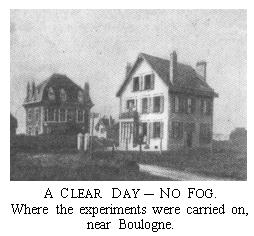
M. Dibos holds a prominent position as consulting engineer of La Foncière-Transports, the leading French maritime insurance company, and in that capacity is constantly called upon to investigate the cause of wrecks and to advise measures for their prevention. During his long professional experience he became impressed with the gigantic importance of fog as a factor in maritime disaster and delay. Not only is fog responsible for the majority of collisions in the open sea, many attended by great loss of life, but it also determines the greater number of casualties to vessels entering or leaving harbor. The suppression of harbor fog will render services of incalculable value to humanity.
On land everybody is familiar with the direful effects of fog in connection with railways. By shrouding the signals, fog has caused many an engine driver to dash his train to destruction and his passengers to a death the very thought of which freezes the blood of nervous travelers. By dispelling fog in the vicinity of signals it may be possible to reduce railway disasters to a minimum--at any rate to help lessen their number.
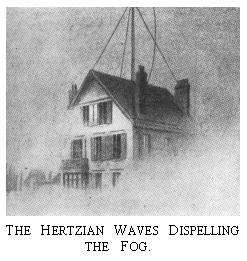
The misdeeds of fog in certain industrial districts have long been a subject of scientific study. In some "black countries" fog prevails almost permanently, and the inhabitants consequently live in a semi-darkness which is not only unpleasant but also unhealthy. Fog impedes the action of health-giving sunlight, particularly of the violet and ultraviolet solar rays that possess the power of destroying disease germs. These rays are absorbed by fog, and cannot exercise their antiseptic action in a foggy region.
Since 1898 M. Dibos has devoted attention to the dispelment of fog with the aid of Hertzian waves in combination with intense heat-waves produced by the admixture of oxygen and hydrogen. His discoveries in connection with Hertzian waves have been already recognized by awards from the Smithsonian Institution, the French Academy of Sciences and the French Society of Civil Engineers, of which he is one of the leading lights.
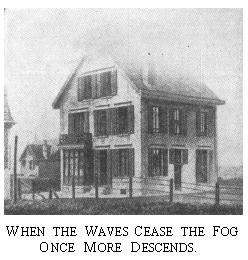
M. Dibos based the tactics of his campaign against fog on Aitkin's theory respecting fog and on Lord Kelvin's investigations. Aitkin considers that fog results from the condensation of tiny drops of water around minute particles of dust, particles so minute that they remain suspended in the air. Lord Kelvin has shown how such condensation of tiny drops of water occurs on the sides of the recipients used in laboratory experiments. Aitken has pointed out that the minute particles of matter suspended in the air form a nucleus for the creation of fog-spots, and says that if these suspended particles did not exist in the air there would be no fog and no clouds. All the excess of aqueous vapors over-saturating the air would fall to the surface of the earth in the form of dew.
The fact that fog is caused by the agglomeration of aqueous vapors around particles of dust explains why fogs are so prevalent in manufacturing districts. The factories emit dense columns of smoke filled with dust particles which accumulate in the atmosphere and form permanent condensation-stations for the aqueous vapors in the air, thus condemning those districts to be perpetually under the reign of King Fog.
It is natural that the sea should be a great producer of fog, as the winds carry particles of various organic and mineral dusts to immense distances from shore.
The practical problem M. Dibos had to face in his fight against fog was to clear the air of the dust-particles forming the nuclei of the fog-spots. The fog-spots hold together in a cohesion that might be compared to that of a honeycomb. If that cohesion and the resulting equilibrium could be destroyed, the dust particles would descend and the condensed water would return to the condition of transparent vapor.
One of M. Dibos' ideas for the dispersion of fog was obtained from an observation he made on a Channel steamer on a foggy day. He noticed that in the trail of the air-shaft from the stoke-room there was a slight diminution of fog extending to some distance. The hot air had dispelled the fog in a line about thirty yards in length. This suggested to him the utilization of hot gases, which he now employs successfully in conjunction with Hertzian waves, the function of these waves being to jar and displace the dust particles, as a stone thrown into a pool sets in motion the water. The tendency of the disturbed dust particles is downward, and as they strike one another their action, aided by the heat, is cumulative in falling toward the earth.
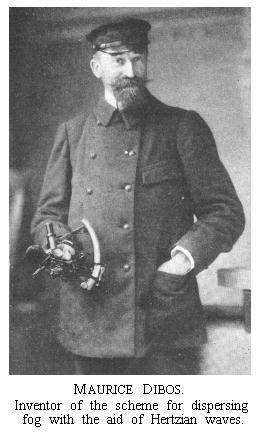
Some time ago M. Dibos invited a small number of scientists and engineers to the Gare du Nord, one of the principal railroad stations in Paris, on a foggy day. He there created a sensation by completely dispelling a dense fog in a zone around the signal points, whereas the line beyond the zone was wrapped in fog of the densest kind.
M. Dibos has effected his latest achievements at Wimereux, close to Boulogne. Over the Villa Excelsior he has raised a mast such as is customarily employed in the process of wireless telegraphy. At the top of the mast he has placed a circular antenna with diffusing points made of copper. With this diffuser he emits Hertzian waves, by secondary current, of a power varying from 380,000 volts to 400,000 volts. Slightly below the Hertzian-wave emitter is a smaller metal circle supporting the nozzles of four blow-pipes for the emission of hot gases derived from the admixture of oxygen and hydrogen. The apertures of these blow-pipes are directed toward the four cardinal points, and from each is emitted a heat-wave of 2,000 degrees centigrade. Rubber tubes connect the apertures with the collector where the admixture of gases is effected. An apparatus the exact nature of which is kept secret for the present controls the emission of the Hertzian waves in connection with the heat waves--a combination which in the opinion of M. Dibos produces the ions that dispel the fog. This controlling apparatus occupies only a small space, and M. Dibos can easily carry it to any point where it is necessary to dispel fog.
Recently during a thick fog M. Dibos dispelled the gloom around the villa over a zone exceeding 200 yards in extent. This zone was maintained free from fog during two hours. When he ceased the emission of his combination of Hertzian waves and heat waves the fog gradually descended again. But while the apparatus was in operation there was an area of more than 200 yards of clear, clean air, whereas outside the zone it was impossible to see more than one or two yards ahead owing to the density of the fog.
Photographs of the villa have been taken in clear weather, others while the Dibos apparatus was dispelling the fog, and still others while the fog was descending again after the working of the apparatus had ceased. A comparison of the two latter is especially interesting as showing how the apparatus forces the fog down to the ground. When the apparatus is set in motion a fog-free space soon becomes noticeable above the station. This gradually extends until an observer standing at some distance from the villa is able to see the roof, the upper story and ultimately the details of the façade and the fence surrounding the house.
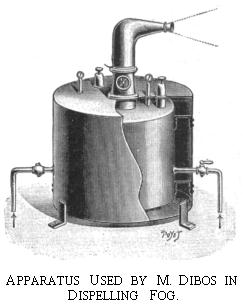
Before utilizing his circular antenna for Hertzian waves M. Dibos employed an antenna provided with a rake-shaped emitter and placed about 33 feet above the villa, which is 95 feet above the sea-level. The electric tension attained at the extremity of the antenna was 140,000 volts, whereas, as mentioned above, M. Dibos now obtains 400,000 volts. With the primary apparatus a fog-free zone of from 110 to 130 yards was obtained. The newer method gives a clear zone of 200 yards, and it is understood that M. Dibos is now able to extend it to 300 yards. The apparatus for the admixture of the heat-producing gases remains the same, and is of the autogenous type.
In his quiet office M. Dibos was found surrounded with models of various inventions which have made his name famous in the technical and engineering worlds. One of these inventions is a diver's helmet provided with a complete telephonic apparatus, which has been adopted by the French navy. On the table were designs for the new system of building tank steamers, a system M. Dibos has devised with a view to obviating the many fatal accidents that are at present associated with the transport of petroleum and such hazardous products. M. Dibos is a man in the prime of life, possessed of true Gallic urbanity and courtesy, and he speaks English fluently.
In connection with the success of his process for dispelling fog, M. Dibos expressed his belief in the unbounded potentialities of Hertzian waves. He recalled the successful application of these waves to photo-telegraphy, and declared his conviction that within a comparatively short time the utilization of Hertzian waves will enable us not only to telephone without wires but at the same time to have before us a portrait of the person with whom we are conversing. He endorses also Dr. Le Bon's conviction that Hertzian waves can be employed to explode torpedoes and even to penetrate the magazines of warships--a contingency which would render naval warfare impossible.
In regard to this fog-dispeller M. Dibos said:
"By my process it is possible to clear of fog an area sufficiently large to enable a vessel to enter port in foggy weather. Fog-dispelling stations can be placed at intervals along the quays in such manner that when the vessel leaves the zone cleared of fog by one station it enters the zone cleared by the succeeding station. When it is desired to clear a channel more than 300 yards wide it will be necessary only to install stations on both sides of the channel in such way as to enable incoming and outgoing steamers to advance without difficulty or danger.
"I anticipate also that my system will do much to diminish the dangers of rail way travel. It is not necessary to have continuous stations all along the line. It will be quite sufficient to place fog-dispelling stations at the signal points. These will enable engine-drivers to see whether the signals are against them or not, and thus free them from doubt and error."




